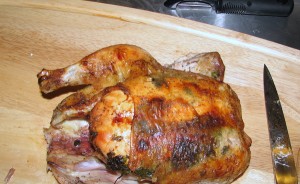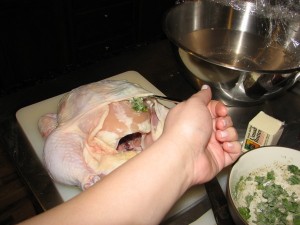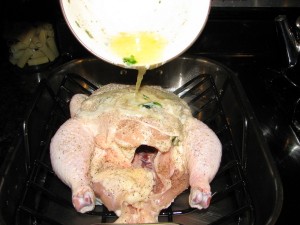 Adam has been quietly, patiently requesting roast chicken in my kitchen experiments pretty much since the day I met him. I had a fear of roasting things that I concquered after a few colorful attempts at Christmas turkeys. I finally got the turkey thing down cold, so this weekend I decided to do a proper Sunday roast. I used my never-fails-me America’s Test Kitchen cookbook (seriously, everything I make from this book is golden) for the recipe. Adam made his famous mashed potatoes (no matter how hard I try, I just can’t make them as good as his), and we grilled some asparagus on the stove. I’m very excited to learn that the asparagus comes out just as awesome inside with a grill pan as it did outside on the grill.
Adam has been quietly, patiently requesting roast chicken in my kitchen experiments pretty much since the day I met him. I had a fear of roasting things that I concquered after a few colorful attempts at Christmas turkeys. I finally got the turkey thing down cold, so this weekend I decided to do a proper Sunday roast. I used my never-fails-me America’s Test Kitchen cookbook (seriously, everything I make from this book is golden) for the recipe. Adam made his famous mashed potatoes (no matter how hard I try, I just can’t make them as good as his), and we grilled some asparagus on the stove. I’m very excited to learn that the asparagus comes out just as awesome inside with a grill pan as it did outside on the grill.
The book suggests brining the chicken first, which I did. Two quarts of cold water mixed with 1/2 cup salt and 1/2 sugar in a big bowl. I totally immersed the chicken, covered it, and refrigerated it for about 40 minutes. And the chicken was unbelievably moist.
Simple Roast Chicken (from America’s Test Kitchen Cookbook)
1 (3.5-4 lb.) whole chicken, brined if desired
3 tablespoons unsalted butter, softened
1 tablespoon minced fresh tarragon, chives, or parsley (I used parsley)
Salt and pepper
1 cup water
1. Put an oven rack in the middle position and preheat the ovento 375 degrees F. Remove the gizzard packet and any excess fat from the inside cavity of the chicken (this had already been done for me when I bought the chicken).
 2. Mix 2 tablespoons of the butter, the herbs, 1/4 tsp salt, and 1/4 tsp pepper in a small bowl. Using your fingers or a spoon, loosen the skin from the breast of the chicken on both sides, making 2 pockets. Spread the butter mixture under the skin of the chicken and massage it all the way down to the end with a spoon or your fingers.
2. Mix 2 tablespoons of the butter, the herbs, 1/4 tsp salt, and 1/4 tsp pepper in a small bowl. Using your fingers or a spoon, loosen the skin from the breast of the chicken on both sides, making 2 pockets. Spread the butter mixture under the skin of the chicken and massage it all the way down to the end with a spoon or your fingers.
3. Spray a V-rack with nonstick spray and put it in your roasting pan (if you don’t have a V-rack, get one. My roaster came with one, and it honestly the best way to roast anything). Pour the cup of water into the bottom of the roasting pan (this helps keep the chicken moist and the drippings from burning). Lay the chicken in the rack, breast side up. Melt the remaining butter and brush over the chicken (I just poured it and massaged it into the skin).
Roast the chicken for 40 minutes at 375.
4. Increase the oven temperature to 450 and turn the roasting pan. Keep roasting it until the juices run clear (or if you’re really concerned, until it’s 170 degrees F at the fattest part of the breast) for about 30 more minutes.
5. Tip the chicken so the juices from the cavity flow out into the bottom of the pan. Move the chicken to a carving board and let it rest uncovered for 20 minutes before carving it.
Quick Gravy for Roast Chicken (from America’s Test Kitchen Cookbook)
I made this gravy right in the roasting pan, and I didn’t skim the fat. Feel free to follow the steps in the recipe, but I basically added the butter straight to the drippings, added the flour and onion, cooked for a few minutes, then slowly added the chicken stock. I simmered it until I was ready to serve, and I didn’t need to add any extra salt and pepper to it. And it was awesome gravy, if you don’t mind it sort of rustic with bits of onion and pan scrapings in it. I love that.
2 tablespoons unsalted butter
1 onion, minced
2 tablespoons all-purpose flour
3 cups low-sodium chicken stock
2 bay leaves (I forgot to add these and it was still delicious)
1 teaspoon minced fresh tarragon, chives, or parsley (I skipped this part, too)
Salt and pepper
1. While the chicken rests, melt the butter in a medium saucepan over medium heat. Add the onion and cook until soft, about 5 minutes. Add the flour and cook until brown, 5-10 minutes.
2. Meanwhile, add 1 cup of the broth to the roasting pan and scrape up any drippings. Pour into a large measuring cup and spoon fat off the top. Add the remaining broth as needed to measure 3 cups total.
3. Slowly whisk the broth/drippings mixture into the saucepan. Add the bay leaves and simmer about 10 minutes. Remove the bay leaves and stir in the herbs. Season with salt and pepper to taste.

